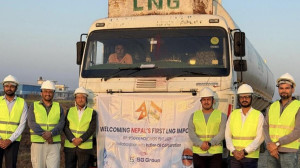Money
Middle class swells to 22pc of population
Nepal’s middle class has swelled to almost one-fourth of the total population over the past one and a half decades, pointing to an improvement in living standards and reduction in poverty, the World Bank said Wednesday.
Nepal’s middle class has swelled to almost one-fourth of the total population over the past one and a half decades, pointing to an improvement in living standards and reduction in poverty, the World Bank said Wednesday.
They made up 22 percent of the population in 2010-11, a sharp rise from 7 percent in 1995-96, according to a World Bank report entitled Moving up the Ladder: Poverty Reduction and Social Mobility in Nepal. The middle class constitutes households with consumption levels high enough for their probability of falling into poverty to be very small.
Interestingly, middle class households are more likely to be headed by those with more than 11 years of education, generally further away from agricultural employment and more likely to be in white collar jobs, the report said. Vulnerability, on the other hand, is highest among those self-employed in agriculture and holding jobs in the service sector, mostly in blue collar occupations.
“Close to half of the urban population is in the middle class and this class prevalence is highest in the Central Development Region, while the Mid- and Far Western regions have the highest incidence of poverty and vulnerability,” the report said. According to economists, people tend to migrate to urban areas when their income levels increase. “Therefore, a large mass of middle class people live in the Central Region,” said Shanker Sharma, former vice-chairman of the National Planning Commission.
The World Bank report said that poverty in Nepal decreased by a steady rate averaging 2.2 percentage points annually between the fiscal years 1995-96 and 2010-11. It currently stands at 25 percent.
Despite overwhelming odds over the last two decades in the form of a decade-long insurgency and a turbulent decade of transition, Nepal made remarkable progress in improving living standards and reducing poverty, it said.
“Off-farm diversification at home and remittances from abroad have been the main tickets out of poverty in the rural areas of Nepal,” the report pointed out. Overall labour incomes accounted for 52 percent while remittances accounted for 27 percent of the poverty reduction observed nationally between 1995 and 2010.
“Labor incomes were boosted not just by an increase in wages in the farm and non-farm sectors, but also by an increase in non-farm activities throughout the country, possibly due to the diversification of the consumption basket brought about by the increase in incomes,” states the report.
According to Sharma, remittances account for around 50 percent of the poverty reduction. “When we look at the multiplier effect of remittance, its contribution in poverty reduction is higher,” said Sharma. “Also, labour migration led to shortages of labour within the country, pushing up wage rates.” So remittance has a far-reaching impact on poverty reduction, he added.
However, along with the movement out of poverty, there has been a significant movement into poverty too. The World Bank analysis shows that 26 percent of the population moved out of poverty while 17 percent moved in the opposite direction and fell into poverty during the period 1995-96 to 2003-04.




 18.12°C Kathmandu
18.12°C Kathmandu












